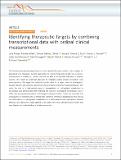Identifying therapeutic targets by combining transcriptional data with ordinal clinical measurements
Author(s)
Dunn, Denise E.; Avila-Pacheco, Julian; Greengard, Paul; Clish, Clary B.; Lo, Donald C.; Pirhaji, Leila; Milani, Pamela; Dalin, Simona; Wassie, Brook T.; Fenster, Robert; Heiman, Myriam; Fraenkel, Ernest; ... Show more Show less
Download41467_2017_Article_353.pdf (3.330Mb)
PUBLISHER_CC
Publisher with Creative Commons License
Creative Commons Attribution
Terms of use
Metadata
Show full item recordAbstract
The immense and growing repositories of transcriptional data may contain critical insights for developing new therapies. Current approaches to mining these data largely rely on binary classifications of disease vs. control, and are not able to incorporate measures of disease severity. We report an analytical approach to integrate ordinal clinical information with transcriptomics. We apply this method to public data for a large cohort of Huntington's disease patients and controls, identifying and prioritizing phenotype-associated genes. We verify the role of a high-ranked gene in dysregulation of sphingolipid metabolism in the disease and demonstrate that inhibiting the enzyme, sphingosine-1-phosphate lyase 1 (SPL), has neuroprotective effects in Huntington's disease models. Finally, we show that one consequence of inhibiting SPL is intracellular inhibition of histone deacetylases, thus linking our observations in sphingolipid metabolism to a well-characterized Huntington's disease pathway. Our approach is easily applied to any data with ordinal clinical measurements, and may deepen our understanding of disease processes.
Date issued
2017-09Department
Massachusetts Institute of Technology. Department of Biological Engineering; Massachusetts Institute of Technology. Department of Brain and Cognitive Sciences; Picower Institute for Learning and MemoryJournal
Nature Communications
Publisher
Nature Publishing Group
Citation
Pirhaji, Leila et al “Identifying Therapeutic Targets by Combining Transcriptional Data with Ordinal Clinical Measurements.” Nature Communications 8, 1 (September 2017): 623 © 2017 The Author(s)
Version: Final published version
ISSN
2041-1723